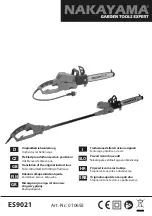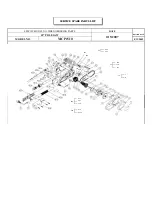
31
E N G L I S H
Safety instructions
When using stationary power tools, always observe the safety
regulations applicable in your country to reduce the risk of fire,
electric shock and personal injury.
Read all of this manual carefully before operating the tool.
Save this manual for future reference.
General
1 Keep work area clean
Cluttered areas and benches can cause accidents.
2 Consider work area environment
Do not expose the tool to rain. Do not use the tool in damp or wet
conditions. Keep the work area well lit (250 - 300 Lux). Do not use the
tool where there is a risk of causing fire or explosion, e.g. in the
presence of flammable liquids and gases.
3 Keep children away
Do not allow children, visitors or animals to come near the work area or
to touch the tool or the mains cable.
4 Dress properly
Do not wear loose clothing or jewellery, as these can be caught in
moving parts. Wear protective hair covering to keep long hair out of the
way. When working outdoors, preferably wear suitable gloves and non-
slip footwear.
5 Personal protection
Always use safety glasses. Use a face or dust mask whenever the
operations may produce dust or flying particles. If these particles might
be considerably hot, also wear a heat-resistant apron. Wear ear
protection at all times.
6 Guard against electric shock
Prevent body contact with earthed or surfaces (e.g. pipes, radiators,
cookers and refrigerators). When using the tool under extreme
conditions (e.g. high humidity, when metal swarf is being produced,
etc.), electric safety can be improved by inserting an isolating
transformer or a (FI) earth-leakage circuit-breaker.
7 Do not overreach
Keep proper footing and balance at all times.
8 Stay alert
Watch what you are doing. Use common sense. Do not operate the
tool when you are tired.
9 Secure workpiece
Use clamps or a vice to hold the workpiece. It is safer and it frees both
hands to operate the tool.
10 Connect dust extraction equipment
If devices are provided for the connection of dust extraction and
collection facilities, ensure that these are connected and properly used.
11 Remove adjusting keys and wrenches
Always check that adjusting keys and wrenches are removed from the
tool before operating the tool.
12 Use appropriate tool
The intended use is described in this instruction manual. Do not force
small tools or attachments to do the job of a heavy-duty tool. The tool
will do the job better and safer at the rate for which it was intended.
Do not force the tool.
Warning!
The use of any accessory or attachment or performance of
any operation with this tool other than those recommended in this
instruction manual may present a risk of personal injury.
13 Check for damaged parts
Before use, carefully check the tool and mains cable for damage.
Check for misalignment and seizure of moving parts, breakage of
parts, damage to guards and switches and any other conditions that
may affect its operation. Ensure that the tool will operate properly and
perform its intended function. Do not use the tool if any part is damaged
or defective.
Do not use the tool if the switch does not turn it on and off. Have any
damaged or defective parts replaced by an authorised D
E
WALT repair
agent. Never attempt any repairs yourself.
14 Do not abuse cord
Never pull the cord to disconnect from the socket. Keep the cord away
from heat, oil and sharp edges.
15 Remove the battery pack
Switch off and wait for the tool to come to a complete standstill before
leaving it unattended. Remove the battery pack when not in use,
before changing any parts of the tools, accessories or attachments and
before servicing.
16 Avoid unintentional starting
Be sure that the tool is switched off before inserting the battery pack.
17 Store idle tools
When not in use, tools must be stored in a dry place and locked up
securely, out of reach of children.
18 Maintain tools with care
Keep the tools in good condition and clean for better and safer
performance. Follow the instructions for maintenance and changing
accessories. Keep all handles and switches dry, clean and free from oil
and grease.
19 Repairs
This tool is in accordance with the relevant safety regulations.
Have your tool repaired by an authorised D
E
WALT repair agent.
Repairs should only be carried out by qualified persons using original
spare parts; otherwise this may result in considerable danger to the user.
Additional safety rules for mitre saws
• Make sure all locking knobs and clamp handles are tight before starting
any operation.
• Do not operate the machine without the guard in position, or if the
guard does not function or is not maintained properly.
• Never use your saw without the kerf plate.
• Never place either hand in the blade area when the saw is connected
to the electrical power source.
• Never attempt to stop a machine in motion rapidly by jamming a tool or
other means against the blade; serious accidents can be caused
unintentionally in this way.
• Before using any accessory consult the instruction manual.
The improper use of an accessory can cause damage.
• Select the correct blade for the material to be cut.
• Observe the maximum speed marked on the saw blade.
• Use a holder or wear gloves when handling a saw blade.
• Do not use blades of larger or smaller diameter than recommended.
For the proper blade rating refer to the technical data. Use only the
blades specified in this manual, complying with EN 847-1.
• Consider applying specially designed noise-reduction blades.
• Do not use HSS blades.
• Do not use cracked or damaged saw blades.
• Do not use any abrasive discs.
• Raise the blade from the kerf in the workpiece prior to releasing the switch.
• Ensure that the arm is securely fixed when performing bevel cuts.
• Do not wedge anything against the fan to hold the motor shaft.
• The blade guard on your saw will automatically raise when the arm is
brought down; it will lower over the blade when the arm is raised.
The guard can be raised by hand when installing or removing saw
blades or for inspection of the saw. Never raise the blade guard
manually unless the saw is switched off.
• The front section of the guard is louvred for visibility while cutting.
Although the louvres dramatically reduce flying debris, there are
openings in the guard and safety glasses should be worn at all times
when viewing through the louvres.
• Keep the surrounding area of the machine well maintained and free of
loose materials, e.g. chips and cut-offs.
Содержание DW017
Страница 1: ...1 DW017 ...
Страница 3: ...3 A1 7 12 14 11 13 8 9 10 17 18 16 15 22 21 20 1 2 3 4 5 6 ...
Страница 4: ...4 A2 32 26 24 25 23 27 28 29 30 31 ...
Страница 5: ...5 A3 A4 B1 B2 C A5 A6 A7 22 33 34 39 29 39 31 14 13 18 3 31 11 35 36 40 40 40 37 38 ...
Страница 6: ...6 D1 D2 E1 E2 21 22 41 22 41 22 2 17 42 44 45 2 43 ...
Страница 7: ...7 45 43 16 E3 G F2 F3 F4 E5 F1 E4 42 43 45 26 45 46 47 48 49 4 5 50 3 52 47 51 53 53 53 55 54 6 ...
Страница 8: ...8 I1 H I2 I3 I4 I5 I6 J 4 56 57 11 3 52 47 51 28 59 58 10 58 9 58 8 30 3 60 ...
Страница 9: ...9 Q K L M N O P R1 27 61 63 62 64 13 20 1 65 ...
Страница 10: ...10 S1 R2 S2 T U A 15 66 12 67 67 32 67 ...
















































